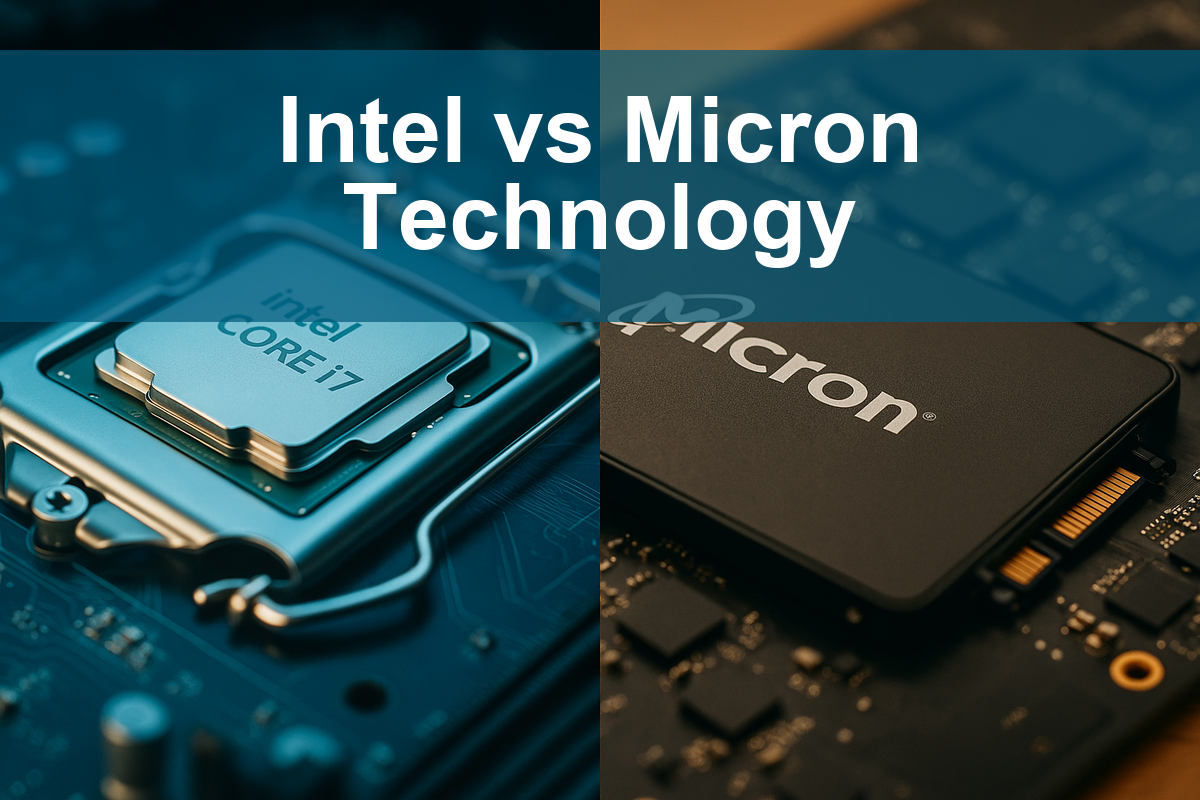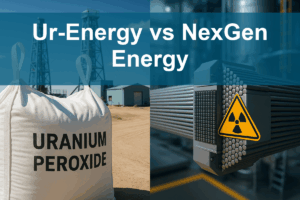In the fast-paced world of semiconductors, two giants stand out: Intel Corporation (INTC) and Micron Technology, Inc. (MU). Both companies play crucial roles in the technology sector, but they focus on different aspects of semiconductor innovation—Intel in processing units and Micron in memory storage solutions. This comparison will delve into their market strategies, competitive advantages, and growth potential. As an investor, understanding these nuances will help you determine which company might be the more compelling addition to your portfolio.

Table of contents
Company Overview
Intel Corporation Overview
Intel Corporation (ticker: INTC) is a leading player in the semiconductor industry, recognized for its design, manufacture, and sale of advanced computer products and technologies globally. The company operates through several segments, including Client Computing Group (CCG) and Data Center Group (DCG), among others. Intel’s mission focuses on innovation, as it develops high-performance computing solutions for various sectors, including healthcare and autonomous driving. As of now, Intel boasts a market capitalization of $178.38B, positioning it prominently within the technology sector. The company has consistently engaged in strategic partnerships, such as with MILA, to enhance artificial intelligence applications in drug research, further underscoring its commitment to advancing technology.
Micron Technology, Inc. Overview
Micron Technology, Inc. (ticker: MU) specializes in the design and manufacture of memory and storage solutions, playing a critical role in the semiconductor market. Established in 1978, Micron operates through four key segments, including Compute and Networking and Mobile Business Units. Its product offerings encompass DRAM, NAND, and NOR memory technologies, which cater to various markets such as cloud, enterprise, and mobile devices. With a market cap of $263.91B, Micron is well-positioned to meet the growing demand for data storage solutions in an increasingly digital world. The company prides itself on providing high-speed and reliable memory products, emphasizing innovation to keep pace with market needs.
Key similarities and differences
Both Intel and Micron operate within the semiconductor industry and share a commitment to innovation and high-performance technology. However, their business models differ significantly. Intel focuses on a broader range of computing solutions, including processors and AI applications, whereas Micron specializes exclusively in memory and storage products. This distinction in product offerings and market focus highlights their unique positioning within the tech landscape.
Income Statement Comparison
The following table compares the most recent income statements for Intel Corporation (INTC) and Micron Technology, Inc. (MU), highlighting key financial metrics to assist in evaluating their performance.
| Metric | Intel Corporation | Micron Technology, Inc. |
|---|---|---|
| Market Cap | 178.38B | 263.91B |
| Revenue | 53.10B | 37.38B |
| EBITDA | 1.20B | 18.49B |
| EBIT | -10.18B | 10.14B |
| Net Income | -18.76B | 8.54B |
| EPS | -4.38 | 7.65 |
| Fiscal Year | 2024 | 2025 |
Interpretation of Income Statement
In the latest fiscal year, Intel faced a significant decline in revenue and reported a net loss, indicative of substantial operational challenges. In contrast, Micron demonstrated robust revenue growth and a healthy net income, reflecting improved operational efficiency and market positioning. Notably, Micron’s EBITDA margin has strengthened, while Intel’s margins have deteriorated. This divergence highlights the contrasting trajectories of these companies, with Micron effectively capitalizing on its market while Intel grapples with increasing costs and declining sales. As an investor, I tread cautiously, considering the risks associated with Intel’s recent performance while recognizing Micron’s potential for continued growth.
Financial Ratios Comparison
Below is a comparative table showcasing the most recent revenue and financial ratios for Intel Corporation (INTC) and Micron Technology, Inc. (MU):
| Metric | Intel Corporation (INTC) | Micron Technology, Inc. (MU) |
|---|---|---|
| ROE | -18.89% | 15.76% |
| ROIC | -12.18% | 12.12% |
| P/E | -4.63 | 15.94 |
| P/B | 0.88 | 2.51 |
| Current Ratio | 1.33 | 2.52 |
| Quick Ratio | 0.98 | 1.79 |
| D/E | 0.50 | 0.28 |
| Debt-to-Assets | 25.45% | 18.45% |
| Interest Coverage | -14.17 | 20.69 |
| Asset Turnover | 0.27 | 0.45 |
| Fixed Asset Turnover | 0.49 | 0.79 |
| Payout ratio | -8.53% | 6.11% |
| Dividend yield | 1.84% | 0.38% |
Interpretation of Financial Ratios
The financial ratios present a stark contrast between Intel and Micron. Intel shows a negative return on equity (ROE) and return on invested capital (ROIC), indicating significant operational struggles. Its P/E ratio is also negative, reflecting losses. Conversely, Micron exhibits positive ratios, suggesting effective management and profitability. However, both companies face challenges in managing debt, with Intel’s interest coverage ratio deeply negative, highlighting potential liquidity concerns. Investors should tread carefully, especially with Intel’s troubling metrics.
Dividend and Shareholder Returns
Intel Corporation (INTC) continues to pay dividends, with a recent yield of approximately 1.8% and a payout ratio of about 18%. However, its negative net income raises concerns about sustainability. In contrast, Micron Technology, Inc. (MU) does not pay dividends, focusing instead on reinvestment for growth, reflected in its high capital expenditures. Both companies engage in share buybacks, which may support shareholder value. Overall, while INTC’s dividends may provide immediate returns, MU’s strategy could align better with long-term growth potential.
Strategic Positioning
In the semiconductor market, Intel Corporation (INTC) holds a significant market share, focusing on a diverse range of products from CPUs to memory solutions. However, it faces intense competitive pressure from Micron Technology, Inc. (MU), which specializes in high-performance memory and storage solutions. Both companies are challenged by rapid technological disruptions, necessitating ongoing innovation and strategic partnerships to maintain their competitive edge. As an investor, I prioritize understanding these dynamics to make informed decisions.
Stock Comparison
In this section, I will analyze the stock price movements of Intel Corporation (INTC) and Micron Technology, Inc. (MU) over the past year, highlighting key trends, notable highs and lows, and trading dynamics.

Trend Analysis
Intel Corporation (INTC) has experienced a price change of -13.5% over the past year. This marks a bearish trend, indicating a gradual decline in stock price. The stock’s volatility, with a standard deviation of 8.53, confirms the presence of fluctuations in trading activity. The highest price reached was 48.15, while the lowest was 18.89. This trend shows signs of acceleration, suggesting a consistent downward momentum.
Micron Technology, Inc. (MU), on the other hand, has shown a substantial price change of +183.38% over the same period, reflecting a bullish trend. The stock has displayed significant volatility with a standard deviation of 36.98. Its highest price was 246.83, with a lowest price of 64.72. The prevailing trend indicates acceleration, reinforcing a robust upward trajectory.
In summary, while INTC is trending downwards with notable volatility, MU has seen impressive growth and momentum, making it a compelling choice for investors looking for upward momentum in their portfolios.
Analyst Opinions
Recent analyst recommendations for Intel Corporation (INTC) indicate a cautious stance, with a rating of C+. Analysts highlight concerns regarding its price-to-earnings ratio and discounted cash flow. In contrast, Micron Technology, Inc. (MU) enjoys a more favorable rating of B+, supported by strong return on equity and assets. Analysts recommend a buy for MU due to its robust financial health. Overall consensus leans towards a hold for INTC and a buy for MU in 2025.
Stock Grades
In the current market landscape, understanding stock grades is crucial for making informed investment decisions. Below, I’ve compiled the latest stock ratings for Intel Corporation and Micron Technology, Inc., based on credible grading companies.
Intel Corporation Grades
| Grading Company | Action | New Grade | Date |
|---|---|---|---|
| Tigress Financial | Maintain | Buy | 2025-11-04 |
| Barclays | Maintain | Equal Weight | 2025-10-27 |
| Morgan Stanley | Maintain | Equal Weight | 2025-10-24 |
| Rosenblatt | Maintain | Sell | 2025-10-24 |
| Truist Securities | Maintain | Hold | 2025-10-24 |
| Wells Fargo | Maintain | Equal Weight | 2025-10-24 |
| Wedbush | Maintain | Neutral | 2025-10-24 |
| JP Morgan | Maintain | Underweight | 2025-10-24 |
| TD Cowen | Maintain | Hold | 2025-10-24 |
| Needham | Maintain | Hold | 2025-10-24 |
Micron Technology, Inc. Grades
| Grading Company | Action | New Grade | Date |
|---|---|---|---|
| Morgan Stanley | Maintain | Overweight | 2025-11-24 |
| UBS | Maintain | Buy | 2025-11-20 |
| Rosenblatt | Maintain | Buy | 2025-11-17 |
| Morgan Stanley | Maintain | Overweight | 2025-11-13 |
| Wells Fargo | Maintain | Overweight | 2025-11-07 |
| Mizuho | Maintain | Outperform | 2025-10-28 |
| Citigroup | Maintain | Buy | 2025-10-27 |
| Barclays | Maintain | Overweight | 2025-10-20 |
| Mizuho | Maintain | Outperform | 2025-10-17 |
| Citigroup | Maintain | Buy | 2025-10-16 |
Overall, the stock grades for both Intel and Micron indicate a tendency towards maintaining their positions, with several firms rating them as “Buy” or “Overweight.” This suggests a generally positive outlook among analysts, though caution remains advisable due to differing ratings, especially for Intel with some “Sell” and “Underweight” assessments.
Target Prices
The consensus target prices from analysts indicate potential upside for both Intel Corporation and Micron Technology, Inc.
| Company | Target High | Target Low | Consensus |
|---|---|---|---|
| Intel Corporation (INTC) | 52 | 20 | 35.22 |
| Micron Technology, Inc. (MU) | 338 | 150 | 215.47 |
Intel’s consensus target price of 35.22 reflects a moderate upside from its current price of 40.56, while Micron’s target of 215.47 suggests significant potential compared to its current price of 236.48. Overall, analysts maintain optimistic expectations for both stocks within the semiconductor sector.
Strengths and Weaknesses
The following table outlines the strengths and weaknesses of Intel Corporation (INTC) and Micron Technology, Inc. (MU) based on recent financial data.
| Criterion | Intel Corporation (INTC) | Micron Technology, Inc. (MU) |
|---|---|---|
| Diversification | Moderate | High |
| Profitability | Negative margins | Positive margins |
| Innovation | Strong in AI integration | Strong in memory advancements |
| Global presence | Strong | Strong |
| Market Share | 50% in CPUs | 25% in memory |
| Debt level | Moderate (0.5 debt-to-equity) | Low (0.28 debt-to-equity) |
Key takeaways highlight that while Intel struggles with profitability, it maintains a strong global presence and innovation in AI. Conversely, Micron showcases better profitability and a lower debt level, supporting its strong market position.
Risk Analysis
In the following table, I outline the various risks associated with Intel Corporation (INTC) and Micron Technology, Inc. (MU) to help you understand their potential vulnerabilities.
| Metric | Intel Corporation (INTC) | Micron Technology, Inc. (MU) |
|---|---|---|
| Market Risk | High | Moderate |
| Regulatory Risk | Moderate | Moderate |
| Operational Risk | High | High |
| Environmental Risk | Low | Moderate |
| Geopolitical Risk | High | Moderate |
Both companies face significant market and operational risks, primarily due to volatile demand in the semiconductor industry. Recent supply chain disruptions and increasing geopolitical tensions have heightened these risks for both firms.
Which one to choose?
When comparing Intel Corporation (INTC) and Micron Technology, Inc. (MU), several fundamental metrics and market trends stand out. Intel has a market cap of approximately $87B and is currently experiencing a bearish trend with a price decline of 13.5%, while Micron boasts a market cap of around $136B with a robust bullish trend, showing a price increase of 183.38%. Micron’s margins are significantly higher (net profit margin of 22.8% vs. -35.3% for Intel), and it holds a B+ rating compared to Intel’s C+. This suggests a stronger growth potential for Micron.
For investors focused on growth and higher returns, Micron appears to be the more profitable option. Conversely, those seeking stability may still consider Intel, albeit with caution due to its current challenges in profitability.
Specific risks include intense competition in the semiconductor industry and supply chain disruptions for both companies.
Disclaimer: This article is not financial advice. Each investor is responsible for their own investment decisions.
Go further
I encourage you to read the complete analyses of Intel Corporation and Micron Technology, Inc. to enhance your investment decisions:



